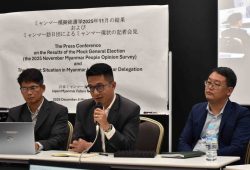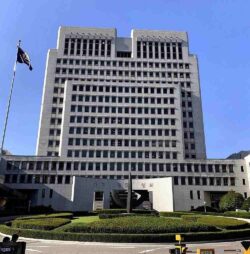
Vice President JD Vance, Secretary of Defense Pete Hegseth and White House national security adviser Michael Waltz.
13:12 JST, March 27, 2025
The Atlantic on Wednesday published a transcript of top Trump administration officials’ group chat discussing an imminent U.S. attack on Houthi militants in Yemen, revealing a fuller accounting of the sensitive information they exchanged while the magazine’s editor, Jeffrey Goldberg, observed their conversation as it occurred over an unclassified, commercially available messaging platform.
The newly disclosed material adds to a mounting controversy about the decision by the nation’s most senior national security officials – including President Donald Trump’s national security adviser, his secretaries of defense and state, the director of national intelligence, the CIA director, and Vice President JD Vance – to discuss sensitive military planning using the messaging app Signal, which is encrypted but not permitted by government rules for discussions of classified information. Further roiling the debate is their total lack of awareness that the group accidentally included a journalist.
Former officials and lawmakers said the negligent tradecraft almost certainly violated the government’s strict rules for handling of classified information and may have risked exposing operational plans to adversaries as American pilots prepared to take flight.
The episode has infuriated Democrats, who have demanded the resignations of Defense Secretary Pete Hegseth and White House national security adviser Michael Waltz, while leaving the White House in the uncomfortable position of having to justify what many former officials and experts have said is a stunning lapse in judgment by nearly all of Trump’s leading national security figures.
While most Republicans have refrained from questioning the administration over the matter, Senate Armed Services Committee Chairman Roger Wicker (R-Mississippi) told reporters Wednesday that he and the committee’s top Democrat, Sen. Jack Reed (Rhode Island), have agreed to seek an expedited report from the Defense Department inspector general. Wicker said that, by his estimation, “the information as published recently appears to me to be of such a sensitive nature that based on my knowledge, I would have wanted it classified.”
The administration, meanwhile, intensified its effort to discredit the Atlantic’s reporting, denying in a fusillade of social media posts that any classified material had been shared in the Signal chat and attempting to draw a distinction between the “war plans” that Goldberg’s initial article cited and the operational information that Hegseth disclosed to the group several hours before the first bombs fell.
The newly released material includes a message sent by Hegseth at 11:44 a.m. Eastern time on March 15, the day of the Yemen operation, confirming the timeline of the planned strikes scheduled to commence roughly two hours later. Hegseth also disclosed the type of aircraft involved – manned F-18 jets and MQ-9 Reaper drones – along with commanders’ intent to employ sea-based Tomahawk missiles, and the fact that one high-profile target was “at his known location.”
The president’s defenders have acknowledged that Goldberg was inadvertently included in the chat while seeking to downplay the significance of what was shared there. Hegseth has denied it contained classified information, telling reporters during a trip to the Pacific region that his role was to provide “general updates in real time.” What he and others wrote had “no units, no locations, no routes, no flight paths, no sources, no methods, no classified information,” he said.
But veteran national security professionals said such advance information, regardless of how it was described, would almost certainly be considered classified, meaning it should not have been communicated on a commercial platform.
“This information was clearly taken from the real-time order of battle sequence of an ongoing operation. It is highly classified and protected,” said Mick Mulroy, a former CIA paramilitary officer and Marine Corps veteran who served as a senior Pentagon official during Trump’s first term. “Next to nuclear and covert operations, this information is the most protected.”
Trump, in remarks in the Oval Office, said Waltz “took responsibility” for the situation and dismissed scrutiny of the issue. Asked about Hegseth’s role, Trump said the defense secretary is “doing a great job.”
“How do you bring Hegseth into it?” Trump asked. “Look, look: It’s all a witch hunt.”
Trump indicated he is open to an inspector general review of the issue. Like others in the administration, he pivoted to discussing the operations, which officials have described as part of a tougher stance against Iran, saying the Iranian-backed group is “getting the hell knocked out of them.”
Airstrikes have continued against the Houthis, who function as the de facto government across much of Yemen, since the March 15 attacks.
Hegseth, Vance and other officials in their broadsides against the Atlantic this week have focused on the magazine’s description of what was shared in the chat as “war plans.”
“I would characterize this messaging thread as a policy discussion – a sensitive policy discussion, surely – amongst high-level Cabinet officials and senior staff,” White House press secretary Karoline Leavitt told reporters.
Current and former officials have said that in military jargon the term “war plan” typically refers to an operational or “O-plan,” usually a notional, high-level blueprint developed in advance of different scenarios, addressing a host of different dimensions for a battlefield effort, which does not typically include information such as strike timing or aircraft choice. The information shared by Hegseth, outlining specific strike procedures, laid out details at a more granular level.
But either type of plan, officials cautioned, would be sensitive and highly classified.
“One could actually make the argument that attack plans are more sensitive because they are more detailed and specific on time, place and manner,” Mulroy said.
Goldberg, speaking to MSNBC, said Leavitt appeared to be “playing at some sort of weird semantic game.”
“This is operational details about a forthcoming attack on an enemy that has antiaircraft capabilities. They’ve allegedly shot down our drones before,” he said. “If that’s not secret, classified information … or the most sensitive kind of government information in the world, I don’t know what it is.”
According to U.S. Central Command, in the period from mid-January until the March 15 attacks, the Houthis fired a surface-to-air missile at a piloted American F-16 fighter jet and also shot at two Reaper drones, taking one down.
The transcript published by the Atlantic on Wednesday includes the message sent by Hegseth confirming the precise timeline of the planned strikes. Hegseth wrote:
TEAM UPDATE:
TIME NOW (1144ET): Weather is FAVORABLE. Just CONFIRMED w Centcom we are a GO for mission launch.
1215et: F-18s LAUNCH (1st strike package)
1345: “Trigger Based” F-18 1st Strike Window Starts (Target Terrorist is @ his Known Location so SHOULD BE ON TIME) – also, Strike Drones Launch (MQ-9s)
1410: More F-18s LAUNCH (2nd strike package)
1415: Strike Drones on Target (THIS IS WHEN THE FIRST BOMBS WILL DEFINITELY DROP, pending earlier “Trigger Based” targets)
1536: F-18 2nd Strike Starts – also, first sea-based Tomahawks launched.
MORE TO FOLLOW (per timeline)
We are currently clean on OPSEC.
Godspeed to our warriors.
Waltz later provided the chat group with information on the strikes’ impact, saying a building had collapsed and that multiple targets were believed killed – including a “top missile guy” who was allegedly struck while “walking into his girlfriend’s building.”
“Pete, Kurilla, IC, amazing job,” Waltz wrote, referring to Hegseth, U.S. Central Command chief Gen. Michael “Erik” Kurilla and the intelligence community.
Other participants in the group chat included Secretary of State Marco Rubio, Director of National Intelligence Tulsi Gabbard, CIA Director John Ratcliffe and several other senior Trump aides.
In testimony before the Senate Intelligence Committee on Tuesday, Gabbard and Ratcliffe echoed Hegseth in asserting that the messages did not include classified material. FBI Director Kash Patel has declined to say whether his agency would launch an examination of the incident.
Rubio, speaking to reporters in Jamaica, referred to the impact of the March 15 operation on Houthi targets and follow-up U.S. strikes, which have continued since then.
“I have been assured by the Pentagon and everyone involved that none of the information that was on there, though not intended to be divulged – obviously that was a mistake and that shouldn’t have happened, and the White House is looking at it – but that none of the information on there at any point threatened the operation or the lives of our servicemen,” he said. “And in fact, it was a very successful operation.”
There are vulnerabilities within Signal, including use of linked devices, and information shared on the app is a “high value target” of Russian hackers, according to a February internal bulletin circulated by the National Security Agency and obtained by The Washington Post. The Houthis, who receive intelligence support from Iran, also have a burgeoning defense relationship with Moscow, officials have said.
Wes Bryant, a former Air Force Special Operations targeter who oversaw strikes against the Islamic State, said Hegseth’s specificity in the Signal chat raises the question of whether he was copying or relaying information straight from classified systems.
There could have been serious consequences had an adversary intercepted the communications and disclosed it to the Houthis, Bryant said. At a minimum, Houthi leaders, if warned, could have sought to evade the U.S. strikes, forcing a delay on the U.S. military’s part or requiring a different calculus about civilian deaths. In the worst-case scenario, he said, the militant group – which generally has outdated air defense systems – could target U.S. or partner aircraft with enough lead time.
“There could be a highly capable air defense asset that we don’t know about at all, run by one of our peer adversaries, or at least facilitated by one,” he said.
"News Services" POPULAR ARTICLE
-

American Playwright Jeremy O. Harris Arrested in Japan on Alleged Drug Smuggling
-

Taiwan President Shows Support for Japan in China Dispute with Sushi Lunch
-

Japan’s Nikkei Stock Average as JGB Yields, Yen Rise on Rate-Hike Bets
-

Japan’s Nikkei Stock Average Licks Wounds after Selloff Sparked by BOJ Hike Bets (UPDATE 1)
-

Japanese Bond Yields Zoom, Stocks Slide as Rate Hike Looms
JN ACCESS RANKING
-

Japan’s Hopes for Seafood Exports Shot Down in China Spat
-

Essential Services Shortage to Hit Japan’s GDP By Up to ¥76 Tril. By 2040
-

Japan to Charge Foreigners More for Residence Permits, Looking to Align with Western Countries
-

Japan Exports Rise in October as Slump in U.S. Sales Eases
-

Japan GDP Down Annualized 1.8% in July-Sept.























